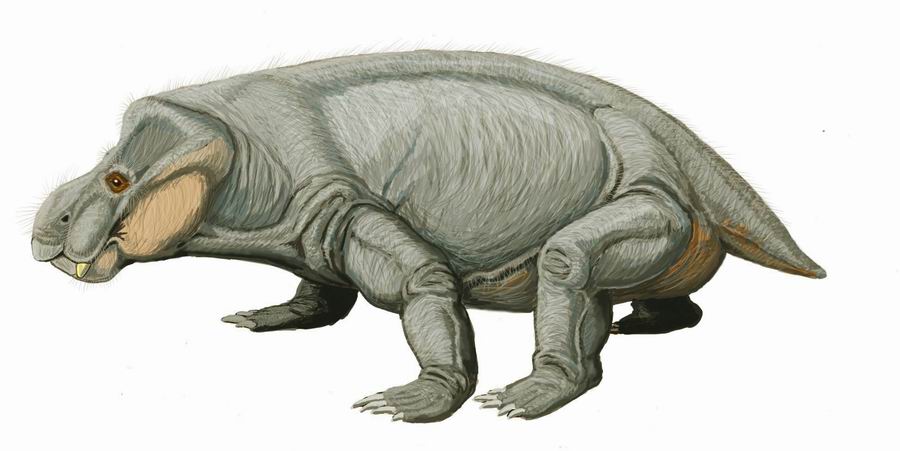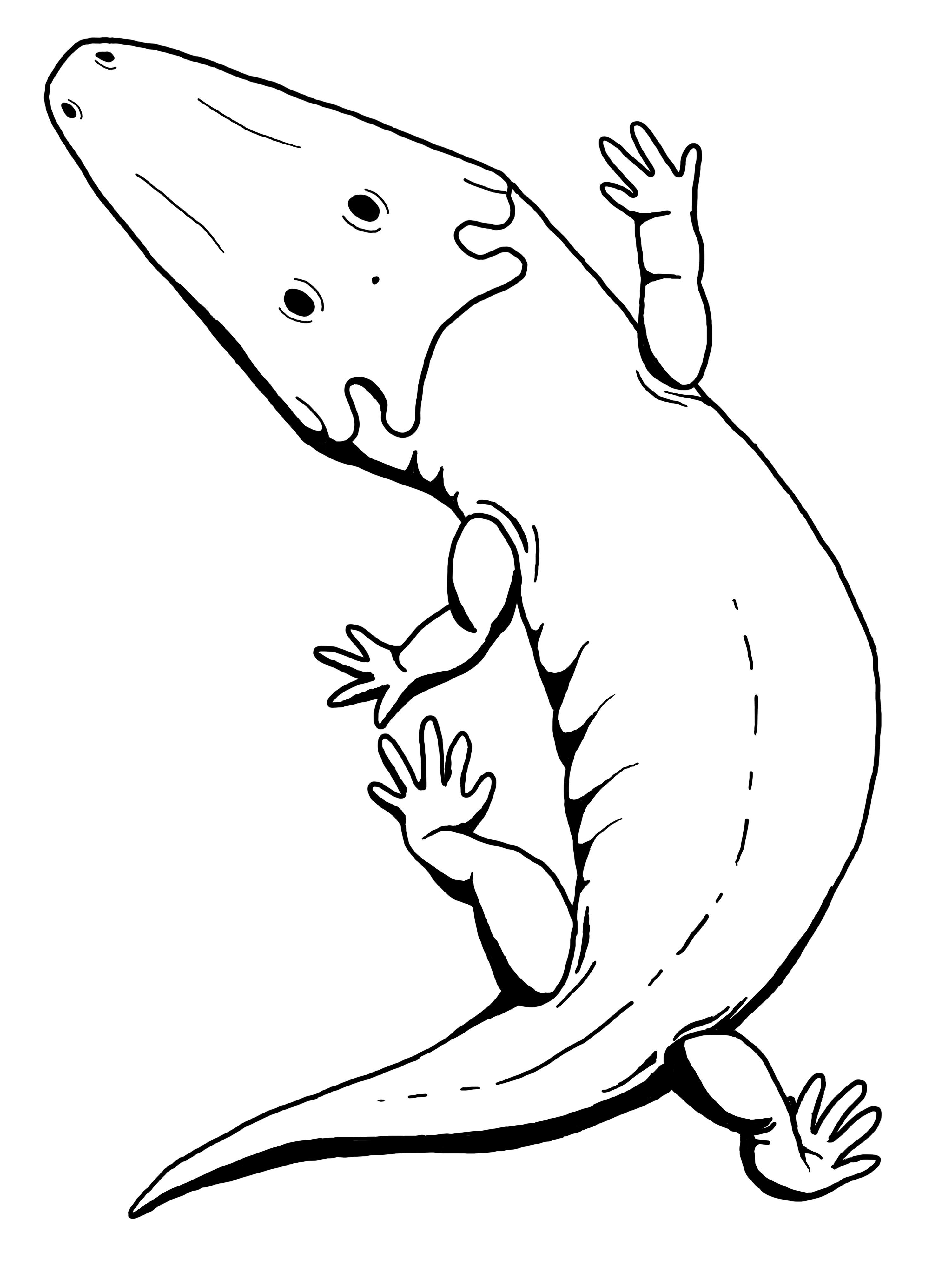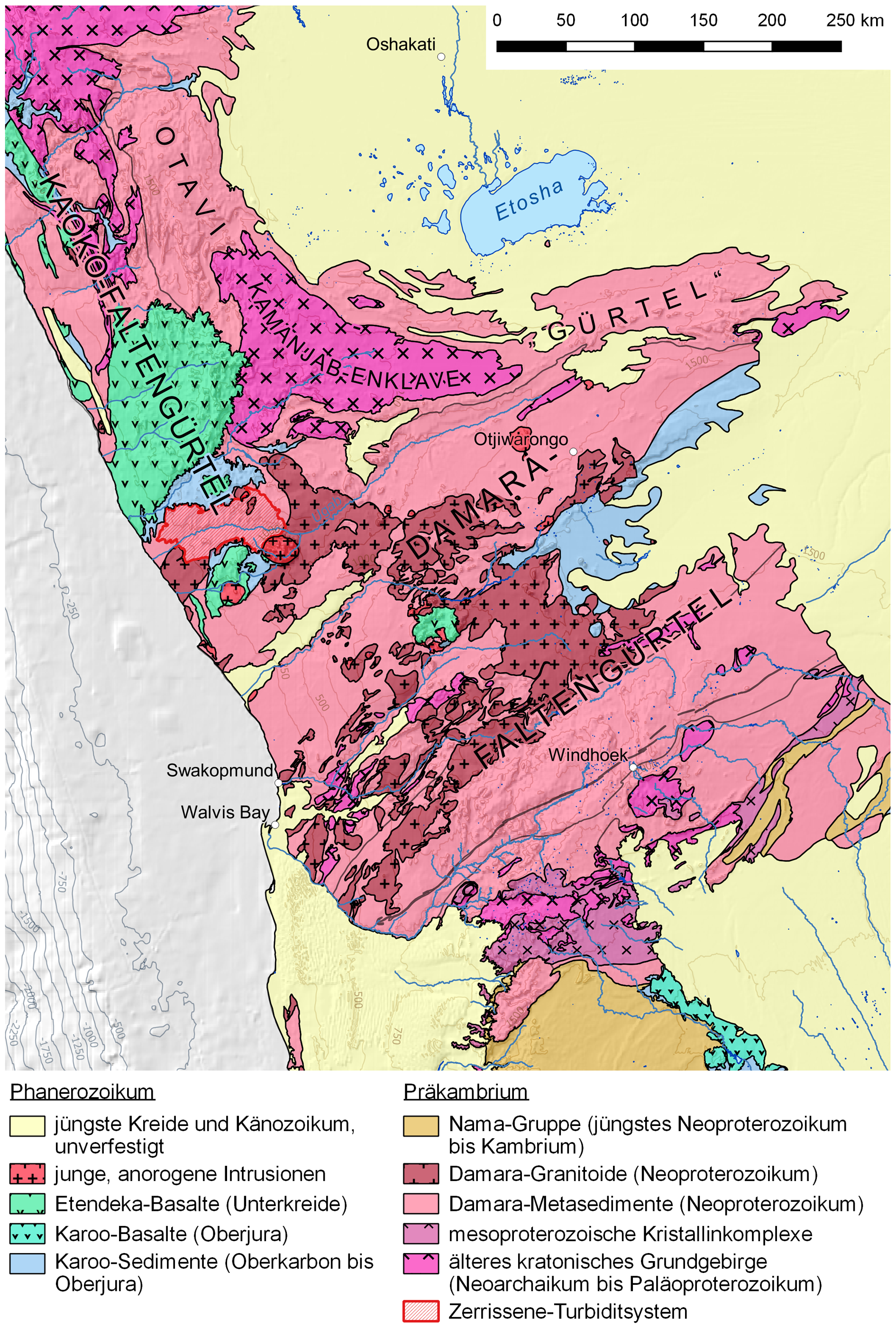|
Kannemeyeria
''Kannemeyeria'' is a genus of dicynodont that lived during the Anisian age of Middle Triassic period in what is now Africa and South America. The generic name is given in honor of Dr. Daniel Rossouw Kannemeyer, the South African fossil collector who discovered the original specimen. It is one of the first representatives of the family, and hence one of the first large herbivores of the Triassic. Description ''Kannemeyeria'' was about in length, about the size of an ox. Although it had a large head, it was lightweight due to the size of the eye sockets and nasal cavity. It also had limb girdles which formed massive plates of bone that helped support its heavily built body. ''Kannemeyeria'' was well-adapted to living as a herbivore; it had a powerful beak and strong jaw muscles built for shearing plant material. ''Kannemeyeria'' had a massive head with unusually large openings for the eyes, nostrils and jaw muscles. It evidently tore up roots, stripped leaves from the vegeta ... [...More Info...] [...Related Items...] OR: [Wikipedia] [Google] [Baidu] |
Cynognathus Assemblage Zone
The ''Cynognathus'' Assemblage Zone is a tetrapod biozone utilized in the Karoo Basin of South Africa. It is equivalent to the Burgersdorp Formation, the youngest lithostratigraphic formation in the Beaufort Group, which is part of the fossiliferous and geologically important Karoo Supergroup. The '' Cynognathus'' Assemblage Zone is the youngest of the eight biozones found in the Beaufort Group, and is considered to be late Early Triassic (Olenekian) to early Middle Triassic (Anisian) in age (around 247 Ma). The name of the biozone refers to '' Cynognathus crateronotus'', a large and carnivorous cynodont therapsid which occurs throughout the entire biozone. History The first fossils to be found in the Beaufort Group rocks that encompass the current eight biozones were discovered by Andrew Geddes Bain in 1856. However, it was not until 1892 that it was observed that the geological strata of the Beaufort Group could be differentiated based on their fossil taxa. The initial undert ... [...More Info...] [...Related Items...] OR: [Wikipedia] [Google] [Baidu] |
Kannemeyeria Skull
''Kannemeyeria'' is a genus of dicynodont that lived during the Anisian age of Middle Triassic period in what is now Africa and South America. The generic name is given in honor of Dr. Daniel Rossouw Kannemeyer, the South African fossil collector who discovered the original specimen. It is one of the first representatives of the family, and hence one of the first large herbivores of the Triassic. Description ''Kannemeyeria'' was about in length, about the size of an ox. Although it had a large head, it was lightweight due to the size of the eye sockets and nasal cavity. It also had limb girdles which formed massive plates of bone that helped support its heavily built body. ''Kannemeyeria'' was well-adapted to living as a herbivore; it had a powerful beak and strong jaw muscles built for shearing plant material. ''Kannemeyeria'' had a massive head with unusually large openings for the eyes, nostrils and jaw muscles. It evidently tore up roots, stripped leaves from the vegeta ... [...More Info...] [...Related Items...] OR: [Wikipedia] [Google] [Baidu] |
Kannemeyeria DB
''Kannemeyeria'' is a genus of dicynodont that lived during the Anisian age of Middle Triassic period in what is now Africa and South America. The generic name is given in honor of Dr. Daniel Rossouw Kannemeyer, the South African fossil collector who discovered the original specimen. It is one of the first representatives of the family, and hence one of the first large herbivores of the Triassic. Description ''Kannemeyeria'' was about in length, about the size of an ox. Although it had a large head, it was lightweight due to the size of the eye sockets and nasal cavity. It also had limb girdles which formed massive plates of bone that helped support its heavily built body. ''Kannemeyeria'' was well-adapted to living as a herbivore; it had a powerful beak and strong jaw muscles built for shearing plant material. ''Kannemeyeria'' had a massive head with unusually large openings for the eyes, nostrils and jaw muscles. It evidently tore up roots, stripped leaves from the vegeta ... [...More Info...] [...Related Items...] OR: [Wikipedia] [Google] [Baidu] |
Dicynodont
Dicynodontia is an extinct clade of anomodonts, an extinct type of non-mammalian therapsid. Dicynodonts were herbivorous animals with a pair of tusks, hence their name, which means 'two dog tooth'. Members of the group possessed a horny, typically toothless beak, unique amongst all synapsids. Dicynodonts first appeared in Southern Pangaea during the mid-Permian, ca. 270–260 million years ago, and became globally distributed and the dominant herbivorous animals in the Late Permian, ca. 260–252 Mya. They were devastated by the end-Permian Extinction that wiped out most other therapsids ca. 252 Mya. They rebounded during the Triassic but died out towards the end of that period. They were the most successful and diverse of the non-mammalian therapsids, with over 70 genera known, varying from rat-sized burrowers to elephant-sized browsers. Characteristics The dicynodont skull is highly specialised, light but strong, with the synapsid temporal openings at the rear of the sk ... [...More Info...] [...Related Items...] OR: [Wikipedia] [Google] [Baidu] |
Ntawere Formation
The Ntawere Formation is a Middle Triassic (Anisian) geological formation in Zambia, preserving fossils of synapsids, archosaurs, and temnospondyls. Geology Several different facies are present in the Ntawere Formation, reconstructing a floodplain environment. The coarsest facies are trough cross-bedded conglomeratic sandstone full of mineral concretions. These coarse deposits formed in ancient channels such as riverbeds. Another type of facies involves thick beds of mudstone interbedding with thinner layers of fine-grained sandstone, indicating alternating low- and high-energy water flow within the channels. Graded sandstone to mudstone overbank deposits (complete with ripple marks) occur near channel deposits. Extensive successions of laminated or massive mudstone are common, often containing slickensides, calcareous nodules or layers (marls), and/or hematite nodules. These types of thick mud/marl layers likely formed in more quiet parts of the floodplain isolated from tur ... [...More Info...] [...Related Items...] OR: [Wikipedia] [Google] [Baidu] |
Omingonde Formation
The Omingonde Formation is an Early Triassic, Early to Middle Triassic (Anisian to Ladinian) geologic Formation (geology), formation, part of the Karoo Supergroup, in the western Otjozondjupa Region and northeastern Erongo Region of north-central Namibia. The formation has a maximum thickness of about and comprises sandstones, shales, siltstones and conglomerate (geology), conglomerates, was deposited in a fluvial depositional environment, environment, alternating between a meandering river, meandering and braided river setting. The Omingonde Formation is correlated with a series of formations in northwestern Argentina and the Paraná Basin in southeastern Brazil, deposited in a larger basinal area, 120 million years before the break-up of Pangea. The formation has provided fossils of several therapsids, amphibians and ichnofossils and belongs to the Cynognathus Assemblage Zone, ''Cynognathus'' Assemblage Zone. The Omingonde Formation preserves the most diverse fauna of Middle Tria ... [...More Info...] [...Related Items...] OR: [Wikipedia] [Google] [Baidu] |
Manda Formation
The Manda Formation (also known as the Manda Beds) is a Middle Triassic (Anisian?) or possibly Late Triassic (Carnian?) geologic formation in Tanzania. It preserves fossils of many terrestrial vertebrates from the Triassic, including some of the earliest dinosauromorph archosaurs. The formation is often considered to be Anisian in age according to general tetrapod biochronology hypotheses and correlations to the ''Cynognathus'' Assemblage Zone of South Africa. However, some recent studies cast doubt to this age, suggesting that parts deposits may actually be younger (Carnian) in age. History of study One of the first to study rocks of the Manda Formation was British geologist G. M. Stockley. In 1932, Stockley explored the geology of the Ruhuhu Basin in Tanzania. He called a series of layers dating from the Late Carboniferous to the Middle Triassic the Songea Series and divided it into eight units labelled K1-K8. Stockley was also the first to describe fossils from these rocks, ... [...More Info...] [...Related Items...] OR: [Wikipedia] [Google] [Baidu] |
Daniel Rossouw Kannemeyer
Daniel Rossouw Kannemeyer (26 December 1843 Cape Town – 1 January 1925 Bloemfontein) was a South African medical practitioner, naturalist, archaeologist and palaeontologist, the son of Daniel Gerhardus Kannemeyer and Johanna Susanna Rossouw He is best remembered for his contributions to palaeontology and archaeology although his collections of zoological specimens are greatly valued by the museums which acquired them. Kannemeyer's family settled in Burgersdorp in the Eastern Cape around 1848. Daniel was a pupil at the South African College in Cape Town between 1859 and 1863. Next he qualified in 1871 as Bachelor of Medicine (MB) and was later licensed to practice by the Royal College of Physicians of Edinburgh. During that same period he married Helen Hill of Edinburgh in November 1871. The couple returned to Burgersdorp and Kannemeyer practised there, in Aliwal North and Smithfield for the next forty years. His wife was locally acclaimed for her soprano voice, while he served ... [...More Info...] [...Related Items...] OR: [Wikipedia] [Google] [Baidu] |
1908 In Paleontology
Arthropoda Newly named insects Archosauromorphs Newly named basal archosauromorphs Newly named dinosaurs Data courtesy of George Olshevsky's dinosaur genera list. Synapsids Non-mammalian References {{portal, Paleontology ... [...More Info...] [...Related Items...] OR: [Wikipedia] [Google] [Baidu] |
Shaanbeikannemeyeria
''Shaanbeikannemeyeria'' is an extinct genus of dicynodont known from the Early Triassic of China. It contains a single species, ''S. xilougoensis'', which was described in 1980 by Zheng-Wu Cheng from a skull catalogued as IGCAGS V315. The specimen was lost, and a neotype skull IVPP V 11674 was later designated. A second species, ''S. buergondia'', was named by Jin-Lin Li in 1980 from a partial skeleton, but it has since been regarded as a synonym of ''S. xilougoensis''. Paleobiology ''Shaanbeikannemeyeria'' hails from the Ermaying Formation, which also yields the genera '' Fenhosuchus'', ''Eumetabolodon'', ''Halazhaisuchus'', ''Guchengosuchus'', '' Neoprocolophon'', '' Ordosiodon'', ''Wangisuchus'' and '' Shansisuchus''. See also * List of therapsids This list of therapsids is an attempt to create a comprehensive listing of all genera that have ever been included in the Therapsida excluding mammals and purely vernacular terms. The list includes all commonly accepted genera, ... [...More Info...] [...Related Items...] OR: [Wikipedia] [Google] [Baidu] |
South Africa
South Africa, officially the Republic of South Africa (RSA), is the Southern Africa, southernmost country in Africa. It is bounded to the south by of coastline that stretch along the Atlantic Ocean, South Atlantic and Indian Oceans; to the north by the neighbouring countries of Namibia, Botswana, and Zimbabwe; and to the east and northeast by Mozambique and Eswatini. It also completely Enclave and exclave, enclaves the country Lesotho. It is the southernmost country on the mainland of the Old World, and the List of countries and dependencies by population, second-most populous country located entirely south of the equator, after Tanzania. South Africa is a biodiversity hotspot, with unique biomes, plant and animal life. With over Demographics of South Africa, 60 million people, the country is the world's List of countries and dependencies by population, 24th-most populous nation and covers an area of . South Africa has three capital cities, with the executive, judicial and le ... [...More Info...] [...Related Items...] OR: [Wikipedia] [Google] [Baidu] |
Anisian
In the geologic timescale, the Anisian is the lower stage or earliest age of the Middle Triassic series or epoch and lasted from million years ago until million years ago. The Anisian Age succeeds the Olenekian Age (part of the Lower Triassic Epoch) and precedes the Ladinian Age. Stratigraphic definitions The stage and its name were established by Austrian geologists Wilhelm Heinrich Waagen and Carl Diener in 1895. The name comes from ''Anisus'', the Latin name of the river Enns. The original type locality is at Großreifling in the Austrian state of Styria. The base of the Anisian Stage (also the base of the Middle Triassic series) is sometimes laid at the first appearance of conodont species '' Chiosella timorensis'' in the stratigraphic record. Other stratigraphers prefer to use the base of magnetic chronozone MT1n. There is no accepted global reference profile for the base, but one ( GSSP or golden spike) was proposed at a flank of the mountain Deşli Caira in the ... [...More Info...] [...Related Items...] OR: [Wikipedia] [Google] [Baidu] |






